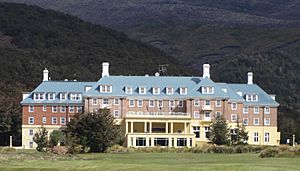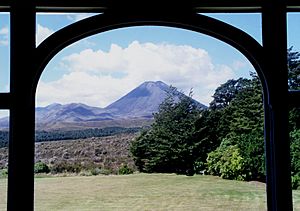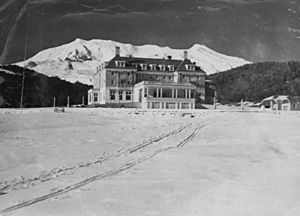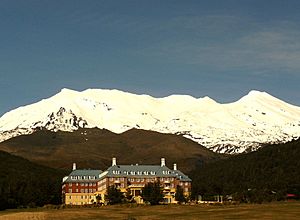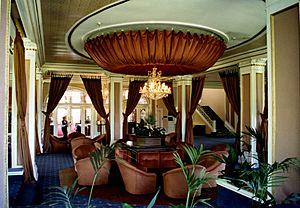Chateau Tongariro facts for kids
The Chateau Tongariro, also known as the Grand Chateau, is a famous hotel and resort in New Zealand. It's located near the Whakapapa skifield on the slopes of Mount Ruapehu. The hotel is also close to the volcanic peaks of Mount Tongariro and Mount Ngauruhoe. All these mountains are inside Tongariro National Park, which is New Zealand's oldest national park. The building was finished in 1929. Even though it has been updated a lot, it still looks like it did before the Great Depression era.
Contents
History of the Chateau
In 1887, Horonuku Te Heu Heu Tūkino, the main chief of the Ngati Tūwharetoa tribe, gave his tribe's land to the people of New Zealand. This land included the sacred mountains of Ruapehu, Ngauruhoe, and Tongariro. He gifted the land to make sure it would always be protected for everyone.
In the early 1900s, getting to Whakapapa was very hard. You had to walk or ride horses for miles through wild country. There were also rivers to cross and mountains to climb. In 1913, climbers Bill Mead and Bernard Drake brought the first skis to the North Island. They were the first to try skiing on Mount Ruapehu. They realized the Whakapapa Valley was great for skiing and summer trips. But it needed a road to get there and some huts.
In 1919, Bill Mead convinced the government's Tourist Department to pay for a road to Whakapapa. This new 'highway' was built towards Mt Ruapehu starting in 1925. Workers from the Whakapapa prison camp helped build it. In 1925, Sir James Gunson drove the first car to Whakapapa. The Ruapehu Ski Club then built many huts, which became Whakapapa Village.
Building the Chateau
In 1923, the new Tongariro National Park Board looked for a place to build a large hotel. They wanted a place with 100 beds to encourage tourists to visit the new Park. In 1925, the New Zealand Government offered to lease land and lend money. They would lend up to £40,000 to any private company that would build and run a hotel there.
Rodolph Lysaght Wigley, who managed the Mount Cook Tourist Company, decided to take this offer. He started the Tongariro Park Tourist Company. His plan was to build what was then called The Chateau. It would be next to the original Whakapapa ski huts on a 63-acre piece of land. To get money for the project, the company sold shares. But not many people bought them.
The company signed a lease with the government on November 9, 1928. A rule of the lease was that the building had to be finished by March 31, 1930. It also had to cost between £40,000 and £60,000. Even though only £30,000 worth of shares were sold, Wigley hired Fletcher Construction Company in late 1928. Fletchers also bought £15,000 worth of shares in the company.
The Chateau was designed by Herbert Hall, an architect from Timaru. He designed it to look like the famous Chateau Lake Louise in Canada. He was inspired by hotels built by the Canadian Pacific Railway. He designed a four-story building with a basement in an American Colonial Revival style. This style was popular between the two World Wars. It's special because it's likely the only building in New Zealand made of reinforced concrete but designed to look like an old brick building.
The first stone was laid on January 10, 1929. Fletchers used 120 carpenters and laborers. They offered free housing and a free suit to workers who stayed until the building was done. Most of the workers came from the Waikune Prison nearby. The hotel opened for guests on August 1, 1929, even though it wasn't fully furnished yet. It officially opened on November 13, 1929. Fletcher Construction was still owed £28,000.
The hotel was very fancy. It had great views from its windows and hot and cold water in every room. The furniture was custom-made and high quality. Most of the staff came from other countries. The heating system was very clever. It used huge boiling-water tanks in the basement. Hot water was pumped up five floors. It was first heated by coal or oil, but later switched to electricity. This system still works today!
The total cost was £88,000, which was much more than planned. The hotel itself cost £78,000. The Tourist Company also asked for £10,000 to be spent on extra wooden buildings, a garage, and a golf course. The golf course was designed by an architect who was in prison and built by prison workers. Wigley had made Fletchers believe that if they spent too much, the Mount Cook Tourist Company would pay them back. But because of the Depression, the Tourist Company was having money problems and couldn't pay.
James Fletcher, the head of Fletcher Construction, talked to the Prime Minister, Sir Joseph Ward. He asked him to increase the government loan to £60,000. Ward agreed. Fletcher also got Wigley to promise that most of this new money would go to pay Fletchers. But the Tongariro Park Tourist Company was in serious financial trouble. They also spent a lot of money making the hotel fancy. Wigley broke his promise and only gave Fletchers £10,000.
The start of the Depression meant fewer tourists. To get their money back, Fletchers took control of the Tongariro Park Tourist Company in February 1931. They ran the hotel for three months. Then they left, losing £19,000 in total.
Government Takes Over
In 1932, the National Park Board took over the hotel. They quickly gave it to the Department of Tourist and Health Resorts. This department owned and ran the hotel for the next 26 years. During this time, the hotel manager not only ran the Chateau but also Tongariro National Park. The only park ranger, Alf Cowling, was told he had to help the Chateau manager. His horse also had to be available for guests to hire.
During World War II, fewer people went skiing. So, in 1942, the Chateau was used by the Health Department as a hospital. This happened after the 1942 Wairarapa earthquakes damaged the Porirua Psychiatric Institution in Wellington. In late 1945, Mount Ruapehu erupted for ten months. Heavy ash showers messed up the Chateau's power and water. The patients had to move to Auckland. After that, the Chateau became a place for Air Force members to rest and get better after serving in World War II.
After the War, the Whakapapa skifield became very popular. New ski-tows, chair lifts, and other facilities were added. In August 1948, the Chateau Tongariro reopened after being updated. It provided rooms for more and more visitors. In 1957, the hotel was given to the new Tourist Hotel Corporation (THC) of New Zealand. This group also developed the Whakapapa skifield. The hotel rooms were slowly improved. The number of rooms went from 90 down to 64. However, the Chateau started to make less money.
Private Ownership
In 1990, the government sold many of its properties. The Chateau was sold to KAH New Zealand Limited. This company is part of Oriental Holdings Berhad (OHB), a large company from Malaysia. OHB owns hotels and restaurants in Singapore and Malaysia. The new owners spent NZ$3 million to update the hotel. They renamed it The Grand Chateau, but many people still call it Chateau Tongariro. The ski area was sold to a different company.
In 2005, a new five-story part was added. It cost NZ$6 million and had 40 rooms. It was built to look just like the original building. To avoid bothering guests, the new rooms were built in Auckland. They were then trucked to the site and put in place using a crane. The Chateau is now run by Bayview International Hotels and Resorts. This company is also part of Oriental Holdings Berhad (OHB).
After the 2008 Global Financial Crisis, fewer people went on skiing holidays. KAH New Zealand lost money for four years in a row. They lost a total of $1.9 million before making a profit again in 2016. In 2020, because fewer tourists came from other countries due to the coronavirus, the Chateau offered cheaper rooms. They had over 3500 bookings in May and June, which are usually quiet months. Tourism New Zealand suggested that the government might buy resorts like Chateau Tongariro again, like they did in 1932. But this idea was not accepted.
Power Supply
The Chateau first got its power from a coal-fired furnace. This furnace heated water that was sent around the building for heating. It also had a 100 kW hydro power station in the Whakapapanui Stream. This station provided electricity for lights and cooking.
By the early 1950s, the power supply was not enough. In June 1952, the Ministry of Works asked the King Country Electric Power Board to provide more power to the Chateau. So, an 8.5-mile long power line was built. It started working in 1955. This line not only powered the Chateau but also the Whakapapa ski field and several mountain huts on Mount Ruapehu. In the early 1960s, a second line was built and started working in 1964. This was done to make the power supply more reliable for the Chateau and other customers in the area.


